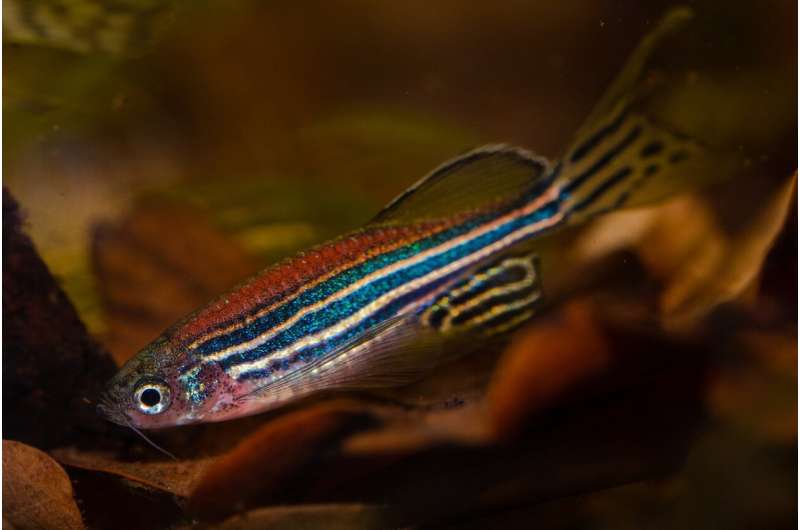Don't go green with envy, but fish might be able to distinguish color more effectively than humans

Researchers have revealed that non-mammalian vertebrates might have a much more simple and effective way of deciphering between color and greyscale information than humans.
Tom Baden, Professor of Neuroscience, and others from his lab at the University of Sussex were investigating how zebrafish respond and decipher between different wavelengths, or colors of light.
Prof. Baden said, "Zebrafish, unlike humans, have four types of cone-photoreceptors, specialized neurons in the retina which respond to light. These four types are often called red, green, blue and UV. The assumption is that each should do what it says on the tin—red should respond to red light, green to green light, and so on. However, we found that this isn't the case."
In the first ever direct in-vivo measurements of "color tuning" from a vertebrate photoreceptor, Prof. Baden and his team, collaborating with researchers at the University of Tübingen, Germany and Baylor College of Medicine in Texas, USA, found that zebrafish can decipher color in a much simpler way to humans. Their study, published by Science Advances, describes how "red cones" responded to brightness, i.e., black or white information, while "green cones" responded to color information.
Prof. Baden explained, "In basic principles, color vision requires visual circuits to disentangle brightness from color information. In nature, these are fundamentally entwined so to disentangle them is no trivial task, which in some cases can require quite a lot of neurons.
"In humans, some of these are distributed all over the eyes and brain in ways that are still far from understood. In contrast, zebrafish solve this basic problem themselves at the earliest possible site, in the synapse of the photoreceptors themselves."
From an evolutionary perspective, Prof Baden explains that this "fish strategy" is probably much closer to the "origin of vision" in vertebrates.
In contrast, during the age of the dinosaurs, humans' early mammalian ancestors are thought to have escaped to the forests and adopted a nocturnal lifestyle. In the process, they lost all but two of their cone-photoreceptor types, resulting in most mammals being dichromatic—only able to see in two colors. Dogs, cats, horses, even hamsters and mice, can all distinguish blues from greens, but none of them can readily distinguish greens from reds. Accordingly, we imagine them to see the world in colors that may be similar to what a red-green color-blind human might experience.
Unlike other mammals, humans and the evolutionary lineage of gorillas and chimpanzees, much later evolved to become trichromatic, regaining some of the lost abilities in color vision. However, this occurs in a much more complicated way, which requires a lot of computation, thought to be performed by the brain rather than within the eye. This is a complex process and means that distinguishing between some colors has to be learnt in early infancy through the developing cortex.
Prof. Baden said, "Our study essentially shows that vertebrates like zebrafish, and presumably most non mammalian vertebrates like other fish, birds, reptiles and amphibians, can actually solve this fundamental 'color puzzle' right at the first synapse of vision. In comparison, humans are stuck with this overly complicated 'knock-off' strategy because of early mammalian ancestry."
The study also references links to insects, as flies also have four such "color vision photoreceptors," determining color in exactly the same way as the zebrafish despite evolving completely independently.
In a follow-up paper, due to be published in Current Biology soon, the researchers use the same technique to investigate the second layer of processing in the retina, the so-called bipolar cells. Expanding on the above results, they show that at this second layer of processing, zebrafish represent three (rather than the previous two) types of color contrast. This "third" is built by comparing UV- to all other wavelength, and it bears striking resemblance to one of the two color channels that humans use—the so called "blue-yellow" system.
Together, the papers imply that the human blue-yellow system is truly ancient, predating the split of tetrapods from fish almost 400 million years ago. It seems that when it comes to seeing color, we do at least share some traits with essentially all vertebrates that see color.
More information: Takeshi Yoshimatsu et al, Ancestral circuits for vertebrate colour vision emerge at the first retinal synapse, (2020). DOI: 10.1101/2020.10.26.356089
Philipp Bartel et al, Spectral inference reveals principal cone-integration rules of the zebrafish inner retina, (2021). DOI: 10.1101/2021.08.10.455697
Journal information: Science Advances , Current Biology
Provided by University of Sussex





















